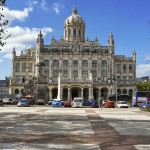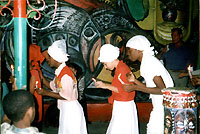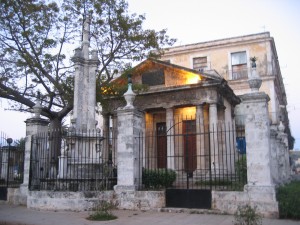La Havana, is the master of time and memory, a saying of the poet Miguel Barnet. The American architect Andres Duany says the Cuban capital as a city in America has the potential to Rome. For Garcia Lorca, Havana was simply “wonderful.” In his “irreducible ambivalence” will see the birth of their charm to the city Dr. Graziella Pogolotti. For the historian Eusebio Leal define Havana is as difficult as defining poetry.
Havana parlera this bustling and well-captured in the paintings of René Portocarrero, maritime, open and unprejudiced, who knows, however, live their own inner life, is a city with all styles and any style, “a unstyled style that eventually, by process of symbiosis, amalgam, stands in a peculiar baroque style serves “as stated by the great Cuban novelist Alejo Carpentier.
City Baroque sense heterogeneous and variegated, and “shy, sober, and hidden” built on a human scale, without ever reaching architecture man crush. That is the historic and modern Havana where skyscrapers and tall buildings, sometimes a bit impersonal, characterless, not cover the sun and prevent the passage of the sea breeze.
Havana is one of the American cities that best retains its historical legacy and its colonial core. The historic founding of the city, in Old Havana, is one of the most important urban ensembles of the continent. There may be 88 monuments of historical and architectural value, environmental value and 860 of 1760 harmonic constructions. Some buildings correspond to the sixteenth and seventeenth centuries. “It’s a monumental par excellence, 90% of its buildings are valuable …” Eusebio Leal accurate.
Do not think you are visiting a museum. In any case, the visitor will be immersed in a living museum, in an area that is home to about 100,000 people and there are offices, schools and commercial establishments. The restoration process that is subjected for years Old Havana avoids make it a static area, dedicated to contemplation, but intends to preserve and revitalize it as a living area in the context of the city and to combine so harmonious, housing office, cultural and tourist.
Modern Havana, Vedado best is the one of the most consistent of contemporary urbanism. That is the opinion of all experts. It is true that, like other parts of the city, is damaged, but it is there and is the most coveted by the inhabitants of the city to reside.
Some of the buildings constructed in the last years clash, are aggressive with their environment, intruders in their environment. But the city must tolerate and accept them.
According to the architect Mario Coyula, this insistence on the value of Old Havana you run the risk of thinking that the rest of the city does not. To him, more than half of the city has architectural value because it appear styles and trends from all eras.
“The essence of Havana is the concert she organized and most importantly there is the scale, the rhythm of light and shadow state in their façades” adds Coyula. In his view there are two important buildings in the city: the Palace of the General Captains, in Old Havana, and the restaurant Ruins in Lenin Park on the outskirts of the capital.
Havana is the first tourist destination in Cuba. Here are the big hotels, cabarets glittering, the most famous restaurants, and a strip of beaches east of the city that extends over more than ten kilometers of fine white sand and crystal clear waters.
Havana also excels in the culture, a mosaic where the Spanish and black joined hands to generate their own identity. They open their doors here about forty museums of first order and its fairs and international film festivals, books, music, art and ballet attract specialists and curious diverse latitudes. Its university, founded in 1728, is very prestigious and medical and scientific institutions are recognized beyond the limits of the Island
In the capital there are the shrines of three of the most venerated saints by Cubans, those of St. Lazarus, the saint of dogs and wooden crutches, the leper of miracles, of Santa Barbara, in the humble neighborhood of Parraga , and the Virgin of Regla, the holy black blue mantle burden in his arms to a white child. Deities in the pantheon of Santeria are identified respectively as Babalu Aye, Shango and Yemaya, mother of all the orishas.
Havana with its touches of holy and lids coconut rolls randomly to read the future and other African rites. Where, sometimes, in the same house attributes are stored and Palo Monte Santeria and Christian images of deities.
Havana rumbas drawer and wooden sandals, the great carnival fun and spontaneous parties in the tenements.
Many claim that Havana is one of the most beautiful cities in the world. Ernest Hemingway, the famous American novelist who lived here the last years of his life, said that in beauty only to Venice and Paris surpassed Havana. Possibly. For now worth ensuring that tropical light, the night on the Malecon, the most popular and cosmopolitan city, and smile and affability of Cuban, among other charms themselves, gain visitors forever.
In the late sixteenth century, in response to its geographical position, someone defined Havana fairly. Called “Key to the New World and Prelude to the Indies.” The German scientist Alexander von Humboldt, whom Cubans consider their second discoverer, saw her as the happiest, quaint and charming towns.
Something here a poet praised as a woman with three lovers rivals: the sun, the sea and the sky … and recently another poet, Fayad Jamis, after noticing their portals and columns, its parks and squares and especially in their lost and forgotten corners, sang as a city of dreams, built on clarity and foam.
In the shade of a ceiba that existed on the northeast side of what would be the Plaza de Armas, Havana was held in the first mass and the first council was formed. The Temple, a monument which was opened in 1828, perpetuates the founding act of the villa. The ceiba you see there now stood in 1959.
In Afro-Cuban religions, La Ceiba is a sacred tree. Blacks from Africa as slaves deposited in it his legend. For believers sit in that tree all the saints, ancestors, spirits Catholic saints and diverse. The ceiba treated saint and not cut or burn or charges without permission of the orishas.
They say who gives three times around the ceiba of El Templete is granted the desire to formulate. So Havana welcoming and generous.
Sources: CiroBianchiRoss/InternetPhotos/YouTube/www.theCubanHistory.com
Anatomy of Cuba/ The Cuban History/ Arnoldo Varona, Editor
ANATOMIA DE LA HABANA
La Habana es la dueña del tiempo y la memoria, dice el poeta Miguel Barnet. El arquitecto norteamericano Andrés Duany asegura que la capital cubana, como ciudad, tiene en la América el potencial de Roma. Para García Lorca, La Habana era, sencillamente, “una maravilla”. De su “irreductible ambivalencia” le ve nacer su encanto a la ciudad la doctora Graziella Pogolotti. Para el historiador Eusebio Leal definir La Habana es tan difícil como definir la poesía.
La Habana, esta ciudad bulliciosa y parlera –tan bien apresada en los lienzos de René Portocarrero- marítima, abierta y desprejuiciada, que sabe, sin embargo, vivir su propia vida interior, es una ciudad con todos los estilos y ningún estilo, “un estilo sin estilo que a la larga, por proceso de simbiosis, de amalgama, se erige en un barroquismo peculiar que hace las veces de estilo”, como afirmara el gran novelista cubano Alejo Carpentier.
Ciudad barroca en su sentido heterogéneo y abigarrado, y también “tímida, sobria, como escondida”, construida a escala humana, sin que la arquitectura llegue jamás a aplastar al hombre. Así sucede en el centro histórico y también en La Habana moderna donde los rascacielos y edificios altos, a veces un tanto impersonales y sin carácter, no tapan el sol ni impiden el paso de la brisa marina.
La Habana es una de las ciudades americanas que mejor conserva su legado histórico y su núcleo colonial. El casco fundacional de la urbe, en la llamada Habana Vieja, es uno de los conjuntos urbanos más importantes del continente. Allí pueden verse 88 monumentos de valor histórico-arquitectónico, 860 de valor ambiental y 1 760 construcciones armónicas. Unas edificaciones corresponden a los siglos XVI y XVII. “Es una zona monumental por excelencia, el 90% de sus edificaciones son valiosas…” precisa Eusebio Leal.
No se piense que se visita un museo. En todo caso el visitante se verá inmerso en un museo viviente, en una zona en la que residen unas 100 000 personas y hay oficinas, escuelas y establecimientos comerciales. El proceso de restauración al que hace años se ve sometida La Habana Vieja rehuye convertirla en una zona estática, dedicada a la contemplación, sino que se propone conservarla y revitalizarla como un área viva en el contexto de la ciudad y que se conjuguen, de manera armoniosa, sus funciones habitacionales, culturales y turísticas.
De La Habana moderna, lo mejor es el Vedado, una de las manifestaciones más coherentes del urbanismo contemporáneo. Esa es la opinión de todos los especialistas. Cierto es que, como otras zonas de la ciudad, está dañado, pero está ahí y es el lugar más codiciado por los habitantes de la ciudad para residir.
Algunos de los edificios construidos en los últimos años desentonan, son agresivos con su entorno, intrusos en su ambiente. Pero la ciudad debe tolerarlos y asumirlos.
A juicio del arquitecto Mario Coyula, se insiste tanto en el valor de La Habana Vieja que se corre el riesgo de pensar que el resto de la ciudad no lo tiene. Para él, más de la mitad de la ciudad tiene valor arquitectónico porque en ella aparecen estilos y tendencias de todas las épocas.
“La esencia de La Habana es el concierto que ella misma organiza y ahí lo más importante es la escala, el ritmo que la luz y la sombra establecen en sus fachadas”, añade Coyula. A su juicio hay dos edificios emblemáticos en la ciudad: el Palacio de los Capitanes Generales, en La Habana Vieja, y el restaurante Las Ruinas, en el Parque Lenin, en las afueras de la capital.
La Habana es el primer polo turístico de Cuba. Aquí están los grandes hoteles, los cabarets rutilantes, los más afamados restaurantes, y una franja de playas al este de la ciudad que se extiende a lo largo de más de diez kilómetros de blanca y fina arena y aguas cristalinas.
La Habana sobresale también en la cultura; un gran mosaico donde lo español y lo negro se dieron la mano para engendrar una identidad propia. Abren sus puertas aquí unos cuarenta museos de primer orden y sus ferias y festivales internacionales de cine, libros, música, plástica y ballet atraen a especialistas y curiosos de latitudes muy diversas. Su universidad, fundada en 1728, es muy prestigiosa y sus instituciones médicas y científicas gozan de reconocimiento más allá de los límites de la Isla.
En la capital se hallan los santuarios de tres de los santos más venerados por los cubanos: los de San Lázaro, el santo de los perros y las muletas de palo, el leproso de los milagros; de Santa Bárbara, en la barriada humilde de Párraga, y de la Virgen de Regla, la santa negra del manto azul que carga en sus brazos a un niño blanco. Deidades que, en el panteón de la Santería se identifican, respectivamente, como Babalú Ayé, Shangó y Yemayá, madre de todos los orishas.
La Habana con sus toques de santo y sus tapas de coco tiradas al azar para leer el futuro y demás ritos africanos. Donde, a veces, en una misma casa se guardan los atributos del Palo Monte y la Santería y las imágenes de las deidades cristianas.
La Habana de las rumbas de cajón y las chancletas de palo, del gran jolgorio del carnaval y de las fiestas espontáneas en las casas de vecindad.
Muchos afirman que La Habana es una de las ciudades más bellas del mundo. Ernest Hemingway, el célebre novelista norteamericano que vivió aquí los últimos años de su vida, decía que en belleza solo Venecia y París superaban a la capital cubana. Es posible. Por lo pronto vale asegurar que la luz del trópico, la noche en el Malecón, el lugar más popular y cosmopolita de la urbe, y la sonrisa y la afabilidad del cubano, entre otros encantos propios, ganan al visitante para siempre.
A fines del siglo XVI, en atención a su posición geográfica, alguien definió a La Habana de manera justa. La llamó “Llave del Nuevo Mundo y Antesala de las Indias”. El sabio alemán Alejandro de Humboldt, a quien los cubanos consideran su segundo descubridor, la vio como la más alegre, pintoresca y encantadora de las ciudades.
Algo más acá un poeta la exaltó como una mujer con tres amantes rivales: el sol, el mar y el cielo… y muy recientemente otro poeta, Fayad Jamís, luego de reparar en sus portales y columnas, sus parques y plazas y, sobre todo, en sus rincones olvidados y perdidos, la cantó como una urbe de sueños, edificada en claridad y espuma.
A la sombra de una ceiba que existía en el lado noreste de lo que sería la Plaza de Armas, se celebró en La Habana la primera misa y se constituyó el primer cabildo. El Templete, monumento que se inauguró en 1828, perpetúa el acto fundacional de la villa. La ceiba que se ve allí ahora se plantó en 1959.
En las religiones afrocubanas, la ceiba es un árbol sagrado. Los negros venidos de África como esclavos depositaron en ella su leyenda. Para los creyentes en ese árbol se asientan todos los santos, los antepasados, los santos católicos y espíritus diversos. La ceiba recibe tratamiento de santo y no se corta ni se quema ni se derriba sin permiso de los orishas.
Dicen que quien da tres vueltas alrededor de la ceiba de El Templete se le concede el deseo que formule. Así es La Habana de acogedora y generosa.
Sources: CiroBianchiRoss/InternetPhotos/YouTube/www.theCubanHistory.com
Anatomy of Cuba/ The Cuban History/ Arnoldo Varona, Editor



 La Havana Anatomy. (Video) * * Anatomia de la Habana. (Video).
La Havana Anatomy. (Video) * * Anatomia de la Habana. (Video).


